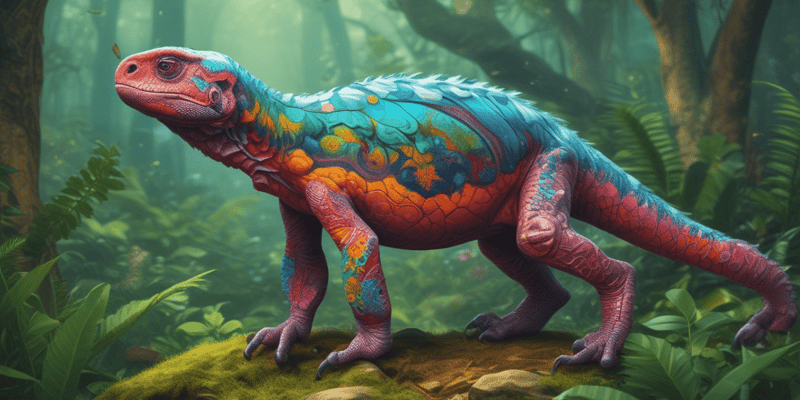Questions and Answers
What is the primary objective of the study of biogeography?
To determine the distribution of species across space and time
What is the significance of the breakup of the supercontinent Pangaea in the context of evolution?
It resulted in the distribution of organisms across different continents
What is the relationship between common ancestry and environmental adaptation in Australian marsupials and placental mammals?
They show similar adaptations due to common ancestry
At which level of organization in living systems can evidence of evolution be seen?
Signup and view all the answers
What is the primary reason why the geographic distribution of organisms follows patterns that are best explained by evolution?
Signup and view all the answers
What is the significance of the study of biogeography in the context of evolution?
Signup and view all the answers
What is the primary purpose of determining the age of fossils and categorizing them from around the world?
Signup and view all the answers
What does the shape of the skull change in as hominids evolved?
Signup and view all the answers
What does comparative genomics reveal about the relatedness of species?
Signup and view all the answers
What is the significance of homologous structures in supporting the theory of evolution?
Signup and view all the answers
What is the relationship between the closeness of species and their hereditary cosmetics?
Signup and view all the answers
What does the fossil record show about the evolution of humans and horses?
Signup and view all the answers
What is the main reason why atomic homology in qualities and proteins over species strengthens the thought of common parentage?
Signup and view all the answers
What is the main function of the modified leaves in the pitcher plant and Venus' flytrap?
Signup and view all the answers
What is the term for the study of formative forms from fertilization to adulthood?
Signup and view all the answers
What do the similitudes in embryonic development among diverse species reveal?
Signup and view all the answers
What is the main function of the modified leaves in the cactus?
Signup and view all the answers
Why are the bright red leaves of the poinsettia thought to be homologous to the plant's green leaves?
Signup and view all the answers
What is the primary significance of the fossil record in providing evidence for evolution?
Signup and view all the answers
What phenomenon is explained by the hypothesis of descent with modification?
Signup and view all the answers
What is the term used to describe the combination of evidence from multiple sources that supports the fact of evolution?
Signup and view all the answers
What is the significance of DNA and protein sequences in providing evidence for evolution?
Signup and view all the answers
What is the primary way in which biogeography provides evidence for evolution?
Signup and view all the answers
What is the significance of direct observation of natural and artificial populations in supporting the theory of evolution?
Signup and view all the answers
What is the primary method by which scientists reveal the evolutionary relationships between different species?
Signup and view all the answers
What is the concept of homology, and how does it support the idea of evolution?
Signup and view all the answers
How does the study of embryology contribute to the evidence for evolution?
Signup and view all the answers
What is the underlying principle that supports the theory of evolution?
Signup and view all the answers
What is the significance of the fossil record in supporting the theory of evolution?
Signup and view all the answers
What is the main concept that underlies the theory of evolution?
Signup and view all the answers
Study Notes
Fossil Record and Evolution
- Fossil record tells the story of the past, showing the evolution of form over millions of years.
- Scientists have recovered highly detailed records of the evolution of humans and horses.
- The shape of the skull changed as hominids evolved.
DNA and Protein Arrangements
- DNA and protein arrangements offer compelling hereditary proof for evolution.
- Comparative genomics uncovers shared genetic codes and groupings, highlighting the relatedness of species.
- The closer species are related, the more prominent the closeness in their genetic cosmetics.
Homology
- Homology refers to the similarity in anatomical structures or genetic sequences between different species, indicating shared developmental origins.
- Homologous structures, such as the pentadactyl appendage found in different vertebrates, mean shared developmental beginnings.
- Molecular homology in genes and proteins across species echoes the theme of common ancestry.
Embryology
- Embryology, the study of formative forms from fertilization to adulthood, completes the mosaic of evidence supporting evolution.
- Similarities in embryonic development among diverse species uncover shared genetic pathways.
Biogeography
- Biogeography, the study of the distribution of species across space and time, provides evidence for evolution.
- Geographic patterns of species often match their geological history, indicating a relationship between common ancestry and environmental adaptation.
- Australian marsupials and other placental mammals exemplify this, showing how evolution has shaped life in response to different ecosystems.
Evidence for Evolution
- The evidence for evolution is compelling and extensive.
- Looking at every level of organization in living systems, biologists see the signature of past and present evolution.
- The fossil record, biogeography, DNA/protein arrangements, homology, and embryology provide a "consilience of inductions" that makes the fact of evolution one of the most securely established generalizations in science.
Studying That Suits You
Use AI to generate personalized quizzes and flashcards to suit your learning preferences.
Description
Explore the various scientific disciplines that support the theory of evolution, including biogeography, the study of species distribution across space and time. Discover how geographic patterns of species match their geological history and learn about other compelling evidence from different fields.




